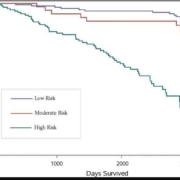Agreement between laboratory‑based and non‑laboratory‑based Framingham risk score in Southern Iran
Authors
Fatemeh Rezaei1 , Mozhgan Seif2 , AbdullahGandomkar3 , Mohammad Reza Fattahi4 & Jafar Hasanzadeh5
Abstract
Introduction: Estimation of the risk of cardiovascular diseases (CVD), may lead to prophylactic therapies. This study aims to compare and evaluate the agreement between CVD prediction of Iran Package of Essential Non-communicable Disease (IraPEN) and Framingham risk score (FRS).
Methods: All 40-79 years old participants in the Yazd Health Study who did not have a history of CVD were included. The 10-years risk of CVD was estimated by the laboratory (IraPEN), non-laboratory WHO-EMR B and FRS. The risk was classified into low, moderate and high-risk groups. Cohen’s weighted kappa statistics were used to assess agreement between tools. To assess discrepancies McNemar’s χ2 test for paired data was used. P values < 0.05 were considered statistically significant.
Results: In total, 2103 participant was included and the risk scores were calculated. Of them, 26.5% were stratified as high risk by FRS, compared with 6.1% by IraPEN. A slight agreement (37.9%) was observed (kappa 0.17, P < 0.0001), in other words. This discrepancy between IraPEN vs. FRS was seen in both sexes (P < 0.0001), although in women the agreement ratio was higher (52.1% vs. 21.3%). The discrepancy between FRS and IraPEN in categorizing people at risk of CVD was 55.5%, (P < 0.0001) but this was not significant between IraPEN and non-laboratory WHO-EMR-B (World Health Organization – Eastern Mediterranean Regional-B group countries) score (P < 0.523; discrepancies, 5.8%).
Conclusion: Our study shows a slight agreement between various CVD risk scores. Thus, reviewing the IraPEN and using alternative tools for the low-risk group should be considered by decision-makers. It is important to use a more reliable score for nation-wide risk assessment.

